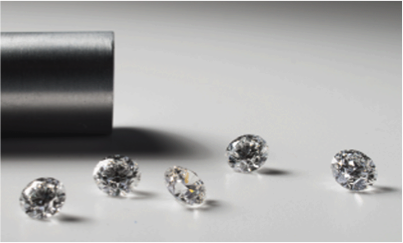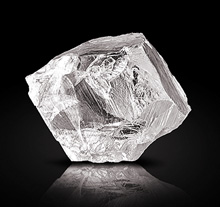November 17, 2015 – Disruptive change is the mantra of so much that Peter Diamandis writes about. In his lasted email blast he talks about the end of diamond scarcity and the implications for the industry. I hope you enjoy the read.
———-
What’s more scarce than perfect diamonds, right?
Wrong.
This week, a new company called Diamond Foundry announced it is able to “grow” hundreds of perfect, “real” diamonds (up to nine carats) in just two weeks in a lab. “Above the line of super credibility,” with the backing of Leonardo DiCaprio and 10 billionaires, my friend Martin Roscheisen is about to disrupt an industry that has been built on the premise of scarcity impacting price for centuries.
More details on Diamond Foundry in a second… but in the meantime, this audacious company really begs the question: what is truly scarce? Ponder that question, and realize that technological advances are a force that convert the seemingly scarce to abundant.
The Lesson of Aluminum
Thousands of years ago, a goldsmith brought an unusual dinner plate to the court of the Roman Emperor Tiberius. The plate was a stunner: made from a new metal, very light, shiny and almost as bright as silver. The goldsmith claimed he had extracted it from plain clay, using a secret technique, a formula known only to him and the gods. Tiberius, though, was a little concerned (and perhaps jealous). Instead of giving the goldsmith a reward he ordered him beheaded.
What the goldsmith had found was aluminum, and his beheading marked a loss to the world for nearly two millennia. Aluminum reappeared during the early 1800s, still rare enough to be considered the most valuable metal in the world. In the mid 1800s, Napoleon III threw a banquet for the King of Siam where the honored guests were given aluminum utensils while others had to make do with gold.
Aluminum’s rarity came down to chemistry. Technically, behind oxygen and silicon, aluminum is actually the third most abundant element in the Earth’s crust making up 8.3%. But you can’t dig up chunks of pure aluminum because all of it is tightly bound as oxides and silicates in a brown clay-like materials called bauxite. Historically aluminum was difficult to separate from bauxite making it more valuable than gold and platinum.
But with the creation of a new breakthrough technology known as electrolysis, discovered in 1886, everything changed. The Hall-Héroult process, as it is now known, liberated the aluminum from bauxite. Suddenly everyone on the planet had access to ridiculous amounts of this light, pliable and now cheap metal.
Technology Transforms Scarcity to Abundance
There are countless examples of technology transforming scarcity into abundance. (Peter coauthored a book by that name.)
- Electrolysis made pure aluminum abundant.
- Google made access to information abundant.
- The mobile phone and Internet has made communications abundant.
- Solar panels are making renewable energy abundant.
Technology is a resource-liberating mechanism.
Speaking of which….now Diamonds are Abundant
Raw diamonds account for roughly $15 billion in sales each year. But a Bain report points out that value is increased downstream “as $15 billion in rough diamonds becomes $24 billion in polished diamonds, which in turn goes into diamond jewelry with a resulting retail value of $71 billion.”
The biggest problem, the diamond mining process is expensive and difficult and the industry has been rife with conflict, violence and corruption.
Enter the Diamond Foundry now culturing diamonds in a California lab, rather than mining them from the Earth. It’s clean, ethical, scalable and significantly cheaper than traditional mining.
How does it work? The process doesn’t yield traditional synthetic diamonds, but instead 100% pure diamonds with the same molecular imperfections of diamonds you find in a mine. That’s because the laboratory diamonds start off as natural diamond.
A recent Forbes article describes the process as similar to growing a plant. You need a seed from another plant to grow a new one. In this case, a small slice of a natural diamond is the base, or seed to grow new layers on top of the crystal until new diamonds are produced. Then the seed base is scraped off and used to grow more new diamonds. All this takes place inside a very hot reactor reaching temperatures of 4,426 Celsius (8,000 Fahrenheit) degrees.
The diamonds are born through the creation of a plasma of unprecedented energy density. That plasma allows atoms to attach themselves to the thin slice of Earth-extracted diamond. The atoms then stack layer by layer on the natural diamond until a pure, jewelry-grade diamond forms. Hundreds of these diamonds can be formed at once in just a few weeks. So far the largest produced weighs nine carats. Diamonds, once a scarce resource, suddenly can become abundant.
So what is truly scarce?
There are lots of things that still are scarce – but, as I wrote in my book, Abundance: The Future is Better Than You Think, it’s only a matter of time before what is scarce becomes abundant. Health, access to the best education, labor, energy, water… even time. Scarcity is contextual, and with the accelerating rate of technological innovation and the convergence of key exponential technologies, I believe we are rapidly approaching a world where nothing is scarce and everything, to some degree, can become abundant.


















[…] tripped over this article by Peter Diamandis and found it pretty interesting. I thought I understood aluminum (considering how much of it I'm […]